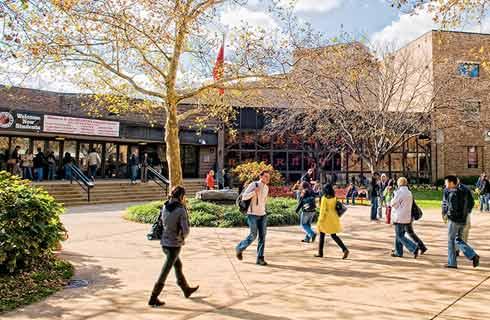- IDP China>
- 课程库>
- 工程与技术>
- 物理科学>
- 地球科学>
- Doctor of Philosophy in Geosciences - Crystal Chemistry and Crystallography
地球科学哲学博士-晶体化学和晶体学
Doctor of Philosophy in Geosciences - Crystal Chemistry and Crystallography

学历文凭
Ph.D.

专业院系
Geosciences

开学时间

课程时长

课程学费

国际学生入学条件
B. A minimum average of B for all undergraduate coursework and a B average for courses in the sciences.
C. Results of the Graduate Record Examination (GRE) General Test.
D. Acceptance by both the Department and the Graduate School.
In special cases, a student not meeting requirements A and B may be admitted on a conditional basis. Upon admission, the student will be informed of the requirements that must be satisfied for termination of this status.
An applicant must have a minimum cumulative grade point average of 3.00 on a 4.00 point scale.
IELTS: Overall score of 6.5, with no subsection recommended to be below 6
TOEFL: 90 for admission to a doctoral program
An applicant must have a minimum cumulative grade point average of 3.00 on a 4.00 point scale.
IDP—雅思考试联合主办方

雅思考试总分
6.5
了解更多
雅思考试指南
- 雅思总分:6.5
- 托福网考总分:90
- 托福笔试总分:160
- 其他语言考试:Duolingo - 110
CRICOS代码:
申请截止日期: 请与IDP顾问联系以获取详细信息。
课程简介
The department has a strong background in the study of earth materials at the atomic and molecular level, and in using the results of these studies to interpret the properties of materials constituting Earth from crust to core. Two centers of excellence, the Center for Environmental Molecular Sciences (CEMS) and the Mineral physics Institute (MPI) concentrate of the behavior of upper crustal and Earth's Interior, respectively. Both employ a wide range of structural probes, some located in the department and others located at national and international synchrotron X-ray and neutron facilities. Within the department, extensive facilities for single-crystal and powder X-ray diffraction, with capabilities for in situ high-temperature and high-pressure studies exist. Projects emphasize crystal structure studies on oxides, hydroxides, sulfides, carbonates, and silicates, including characterization of phase transitions, ordering phenomena, and ion exchange. Convenient access to the Brookhaven National Laboratory and the National Synchrotron Light Source, NSLS, provides opportunities for unique experiments requiring a high-intensity X-ray source. Other projects utilize X-ray absorption spectroscopy to examine local structure in minerals, neutron diffraction for studies of hydrous phases, and solid-state NMR spectroscopy to investigate crystal chemical substitutions and defects. Many of the department's faculty are actively engaged in the design and construction of the next generation of beamlines required for high pressure and environmental investigations. These facilities are being designed with the requirements of the Stony Brook and wider national and international user base in mind. This work is complemented by electron diffraction using the department's transmission electron microscope.
相关申请
 预科
预科 奖学金
奖学金 实习机会
实习机会 在校学习
在校学习 跨境学习
跨境学习 校园授课-线上开始
校园授课-线上开始 在线/远程学习
在线/远程学习
学校排名

世界排名251
数据源:泰晤士高等教育世界大学排名
关于纽约州立大学石溪分校

石溪大学(简称 SBU)成立于 1957 年,位于纽约州长岛,是一所充满活力的公立大学。该大学共有约 25000 名学生,其中包括 17000 多名本科生,支持着一个庞大而多元化的学术社区,同时提供丰富而令人兴奋的大学体验。该大学提供广泛的本科、研究生和博士课程,涵盖多个领域。该校在科学、工程和医学方面拥有坚实的基础,并辅以艺术、人文和社会科学课程。热门专业包括生物医学工程、海岸环境研究和计算机科学,每个专业都将学校的前沿研究与基于实践经验的学习相结合,为学生完成学业后从事专业工作做好准备。根据2024年《美国新闻与世界报道 》,SBU 在纽约州公立大学中排名第一,在全美公立大学中排名第 26 位。同一份研究报告还将该大学的社会流动性排在全美第 12 位,并跻身全美十大最多元化大学之列。SBU 是纽约州立大学(SUNY)系统的一部分,并于 2022 年被纽约州州长正式指定为纽约州立大学的两所旗舰大学之一。该大学的长岛校区为学生提供了一系列美丽的海滩,同时还拥有靠近纽约市的所有优势,为学生提供了丰富的教育和课外活动机会。
本校相关课程

妇女与性别研究文学士
学历文凭
Bachelor Degree
开学日期
课程费用总额


技术系统管理理学学士
学历文凭
Bachelor Degree
开学日期
课程费用总额


可持续发展研究文学学士学位
学历文凭
Bachelor Degree
开学日期
课程费用总额


西班牙语言文学学士学位
学历文凭
Bachelor Degree
开学日期
课程费用总额


社会学文学学士
学历文凭
Bachelor Degree
开学日期
课程费用总额


社会工作科学学士学位
学历文凭
Bachelor Degree
开学日期
课程费用总额

其他相关课程

地球科学哲学博士
 滑铁卢大学
滑铁卢大学学历文凭
Ph.D.
开学日期
课程费用总额


地球科学(荣誉)理学学士
 圣弗朗西斯泽维尔大学
圣弗朗西斯泽维尔大学学历文凭
Bachelor Degree with Honours
开学日期
课程费用总额


环境地球科学(荣誉)理学学士
 阿卡迪亚大学
阿卡迪亚大学学历文凭
Bachelor Degree
开学日期
课程费用总额


环境地球科学理学学士
 阿卡迪亚大学
阿卡迪亚大学学历文凭
Bachelor Degree
开学日期
课程费用总额


地球科学理学硕士
 布鲁克大学
布鲁克大学学历文凭
Masters Degree
开学日期
课程费用总额


哲学地质科学博士
 曼尼托巴大学
曼尼托巴大学学历文凭
Ph.D.
开学日期
课程费用总额





















 美国
美国




